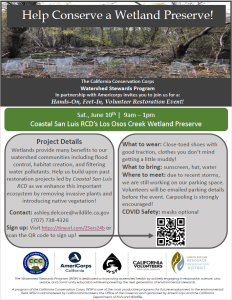Since the completion of Coastal San Luis Resource Conservation District’s (CSLRCD) wetland restoration project in September 2021, Los Osos Creek has been reconnected with its historic floodplain, allowing over 40 acres of wetlands to be reactivated. According to California Water Watch, precipitation levels have reached over 120% of the year-to-date averages across our part of the state this year. These big storm events emphasize the need to slow, spread, and sink stormwater to help prevent the wide-spread flooding that we experienced. Habitats like wetlands protect us from flooding by slowing stormwater momentum and reducing erosive forces.
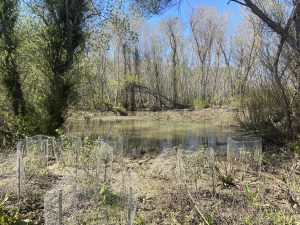
Wetlands: Stormwater Sponges and Biodiversity Hotspots
Wetlands act like a natural sponge, soaking up water during and after storms and slowly releasing it over time. This helps to replenish underground aquifers and reduce flooding. Wetlands also improve water quality by filtering out pollutants like nutrients and allowing sediment from upstream sources to be deposited rather than continuing on to the estuary. In addition to their capacity to store and filter water, wetlands are hotspots of biodiversity. Nutrient-rich soils support a diversity of plant life, which in turn provide food and shelter for fish and wildlife. This includes numerous federally– listed threatened and endangered species such as steelhead trout, tidewater goby, California red-legged frog, Morro shoulderband snail, and least Bell’s vireo.
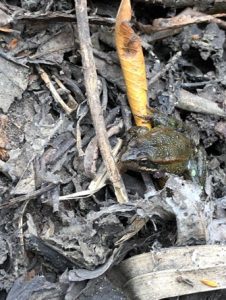
Help Conserve a Wetland Preserve!
Following the CSLRCD’s restoration effort, the Los Osos Creek Wetland is performing the ecosystem services it once performed as an undisturbed wetland. Removing invasive species and revegetating with native species were important components of the restoration project. Maintenance of these plantings are critical during the initial years following restoration as the landscape and habitat adjust to the way water moves through the restored wetland site. CSLRCD is partnering with the Watershed Stewards Program (WSP) on a volunteer event to plant additional native species and remove invasive species.
The Watershed Stewards Program
The Watershed Stewards Program, a special program of the California Conservation Corps in partnership with AmeriCorps and the California Department of Fish and Wildlife, is dedicated to improving watershed health by actively engaging in restoration science, civic service, and community education while empowering the next generation of environmental professionals. Each WSP Corpsmember leads a Watershed Awareness Volunteer Event (WAVE) during their term of service to provide a hands-on watershed restoration opportunity to volunteers in their communities. This event enables Corpsmembers to network with local organizations, develop project management skills, practice professional communication, and serve their communities through tangible restoration projects and watershed education.
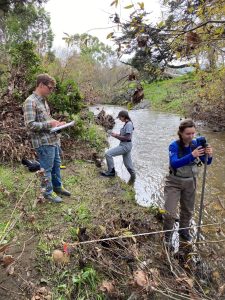
How to Get Involved
On Saturday, June 10th, CSLRCD and WSP will lead a half-day volunteer event at the Los Osos Creek Wetland. This hands-on, feet-in event will provide volunteers the opportunity to remove invasive species (cape ivy and ice plant) and plant native plants while learning about the important role of wetlands in their community.
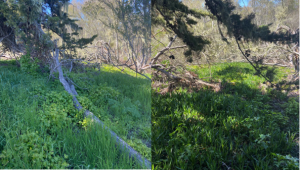
Join CSLRCD and WSP with your sturdy shoes, sunscreen, hats, and smiling faces to help the Los Osos Creek Wetland along its road to restoration. This event will be held from 9am to 1pm. Parking is limited, so carpooling is strongly encouraged!
See the flier below for additional project and registration details or click here to sign up now!
Please direct questions to WSP Corpsmember Ashley, whose contact information is available in the flier below.
Guest Author Ashley Del Core
This is a guest blog post written by Watershed Stewards Program Corpsmember, Ashley Del Core.
Ashley Del Core earned her Bachelor’s degree in Marine Sciences from Cal Poly, San Luis Obispo in 2021. Originally from Vacaville, CA, Ashley developed an interest in marine life, community outreach, and education through her studies at Cal Poly and her role as a Marine Education Fellow at the University of Georgia’s Marine Education Center and Aquarium in 2022. Following her term with WSP, Ashley hopes to pursue graduate school and explore career pathways in marine science.
References
“Flood Preparation Guide.” City of San Luis Obispo. Accessed March 28, 2023. https://www.slocity.org/government/department-directory/public-works/winter-weather-preparedness/flood-preparation-guide.
Morro Bay National Estuary Program. “Partner Spotlight: Los Osos Creek Wetland Restoration by the Coastal San Luis Resource Conservation District.” Morro Bay National Estuary Program. Morro Bay National Estuary Program, August 23, 2022. https://www.mbnep.org/2022/08/26/los-osos-creek-wetland-restoration
“Sources and Solutions: Stormwater.” EPA. Environmental Protection Agency. Accessed March 28, 2023. https://www.epa.gov/nutrientpollution/sources-and-solutions-stormwater.
State of California, Department of Water Resources. “California WATER WATCH.” Department of Water Resources. Accessed March 28, 2023. https://cww.water.ca.gov/.
“Threatened and Endangered Species.” CDFW. Accessed March 28, 2023. https://wildlife.ca.gov/Conservation/CESA.
Help us protect and restore the Morro Bay estuary!
- Donate to the Estuary Program today and support our work in the field, the lab, and beyond.
The Estuary Program is a 501(c)3 nonprofit. We depend on funding from grants and generous donors to continue our work. - Support us by purchasing estuary-themed gear from ESTERO. This locally owned and operated company donates 20% of proceeds from its Estuary clothing line and 100% of Estuary decal proceeds to the Estuary Program. Thank you, ESTERO!
- Purchase items from the Estuary Program’s store on Zazzle. Zazzle prints and ships your items, and the Estuary Program receives 10% of the proceeds. Choose from mugs, hats, t-shirts, and even fanny packs (they’re back!) with our fun Estuary Octopus design, our classic Estuary Program logo, or our Mutts for the Bay logo.
Thank you for helping our beautiful, bountiful, biodiverse bay!
